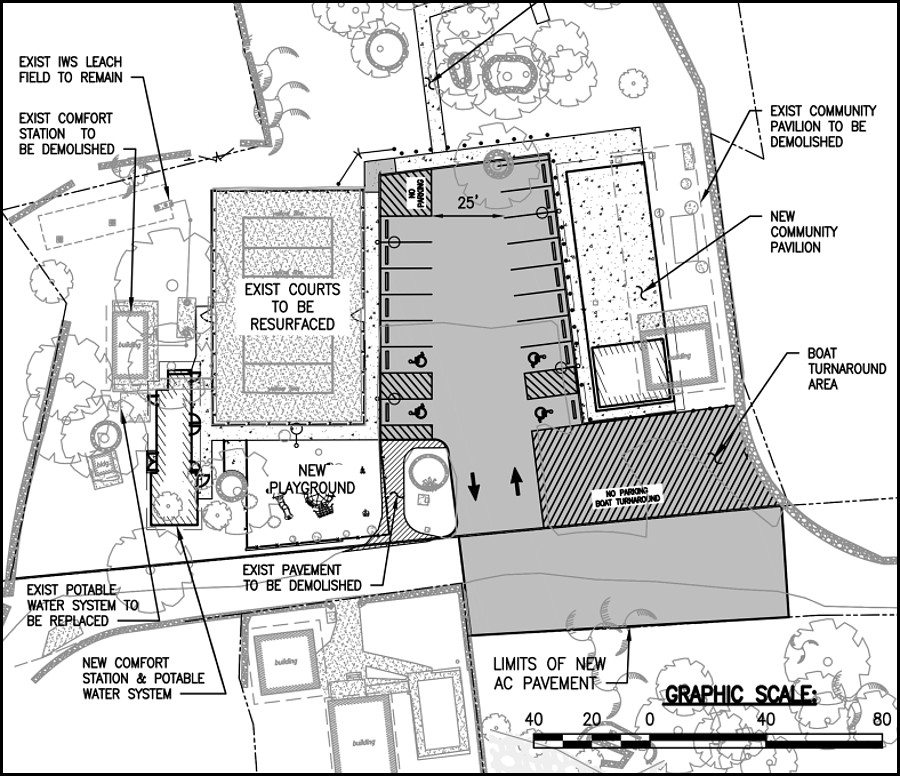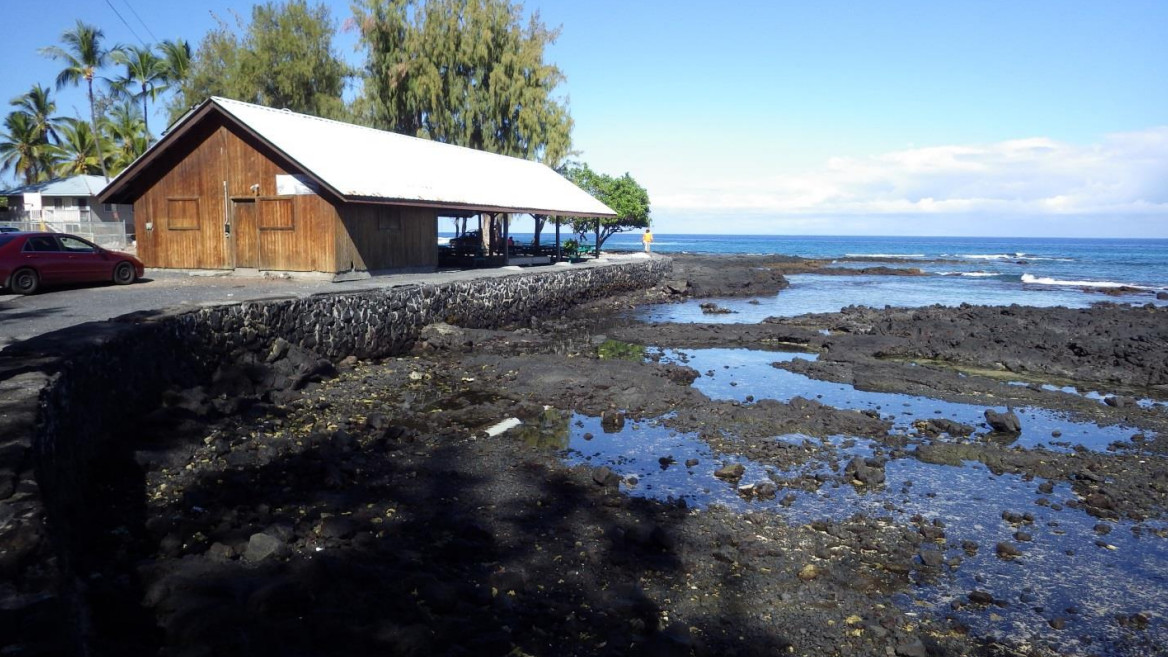
rendering of the site plan published in the Final EA of the Miloliʻi Beach Park Accessibility Improvement Project
(BIVN) – The Final Environmental Assessment for a Hawaiʻi County plan to improve Miloliʻi Beach Park has been published in the February 8 issue of The Environmental Notice.
The County Department of Parks and Recreation is looking to bring the buildings and amenities at the South Kona seaside park into compliance with current Americans with Disabilities Act (ADA) guidelines, enabling better recreational access for disabled visitors to the park.
“The existing Miloliʻi Beach Park parking lot, walkways, and basketball/volleyball courts are in a current state of disrepair, with cracks and eroded areas,” the Final EA document states. “These conditions have impacted park access and safety. Both the restroom and hālau/pavilion structures must be replaced in their entirety due to their age and extensive need for repair and modifications, and because the pavilion is located in the flood zone. Further, the existing pavilion is currently unpermitted, and would be brought up to County standards with implementation of the proposed improvements.”
According to the County, the objectives of the project are:
- To protect the health and safety of the public.
- To bring the existing park facilities into compliance with ADA guidelines and County permit requirements.
- To provide connecting walks and ramps to park facilities for greater accessibility from feature to feature.
- To maintain fishing access for local community.
- To maintain the character of the existing Miloli‘i Beach Park.
- To provide improved recreational facilities for the Miloli‘i community.
- To improve the longevity of existing beach park facilities.
The document also details some “Site-Specific Best Management Practices” that will be incorporated, due to its proximity to the ocean. From the Final EA document:
Due to the proximity of nearshore ocean waters, the project could present increased potential for water quality impacts during construction. The proposed project would include site-specific Best Management Practices (BMP) to be implemented during project construction to minimize erosion and potential impacts to water quality. The BMPs would include but would not be limited to the USFWS recommended standard BMPs regarding sedimentation and erosion in aquatic environments:
1. Turbidity and siltation from project-related work should be minimized and contained within the project area by silt containment devices and curtailing work during flooding or adverse tidal and weather conditions. BMPs should be maintained for the life of the construction period until turbidity and siltation within the project area is stabilized. All project construction-related debris and sediment containment devices should be removed and disposed of at an approved site.
2. All project construction-related materials and equipment (dredges, vessels, backhoes, silt curtains, etc.) to be placed in an aquatic environment should be inspected for pollutants including, but not limited to; marine fouling organisms, grease, oil, etc., and cleaned to remove pollutants prior to use. Project related activities should not result in any debris disposal, non-native species introductions, or attraction of nonnative pests to the affected or adjacent aquatic or terrestrial habitats. Implementing both a litter-control plan and a Hazard Analysis and Critical Control Point plan can help to prevent attraction and introduction of non-native species.
3. Project construction-related materials (fill, revetment rock, pipe, etc.) should not be stockpiled in, or in close proximity to aquatic habitats and should be protected from erosion (e.g., with filter fabric, etc.), to prevent materials from being carried into waters by wind, rain, or high surf.
4. Fueling of project-related vehicles and equipment should take place away from the aquatic environment and a contingency plan to control petroleum products accidentally spilled during the project should be developed. The plan should be retained on site with the person responsible for compliance with the plan. Absorbent pads and containment booms should be stored on-site to facilitate the clean-up of accidental petroleum releases.
5. All deliberately exposed soil or under-layer materials used in the project near water should be protected from erosion and stabilized as soon as possible with geotextile, filter fabric or native or non-invasive vegetation matting, hydro-seeding, etc. These BMPs will be refined in accordance with County of Hawai‘i regulatory requirements as part of the permitting process
The Final EA has been processed as a Finding of No Significant Impact, or FONSI. Therefore, the preparation of an Environmental Impact Statement is not required.


by Big Island Video News9:23 pm
on at
STORY SUMMARY
MILOLIʻI, Hawaiʻi - The Miloliʻi Beach Park Accessibility Improvement Project will bring the pavilion and other park amenities into ADA compliance.